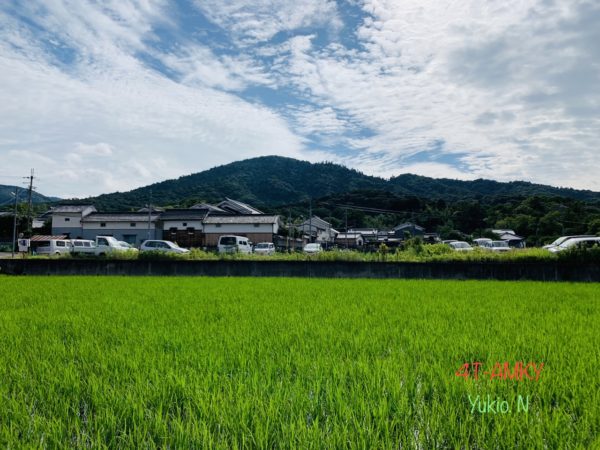There is a mountain called Miwa-yama (Mt. Miwa) in Sakurai city in Nara prefecture. It is a beautiful cone-shaped mountain with smooth slopes.
This mountain is a holy mountain where kami (deities) dwell and has been venerated since ancient times. At the foot of the mountain, there is a shrine that enshrine the kami of Mt. Miwa. The name of the shrine is Omiwa-jinja Shrine.
The Omiwa-jinja Shrine is even mentioned in the Kojiki and the Nihonshoki which are considered the oldest Japanese historical texts composed over 1,300 years ago. Thus, Omiwa-jinja Shrine is believed to be Japan’s oldest shrine.
奈良県桜井市に三輪山という山があります。なだらかな円錐形の美しい山です。
昔から、神様が鎮まる山として、信仰を集めている神の山です。
そのお山の麓には、三輪山の神様をお祀りしている神社があります。大神(おおみわ)神社といいます。
三輪山の神様は、1300年以上も前に編纂された日本最古の歴史書「古事記」や「日本書記」にもでてきます。そのため、大神神社は日本最古の神社と言われています。
Aki Sawaguchi.
Editor: Stuart Cauley.
Chigako Cauley.
Re: Kami
In this blog I uses the Japanese word kami for both the singular and the plural instead of “god” or “gods” to express the object of worship in Shinto according to a book called “English-Japanese SHINTO from an INTERNATIONAL PERSPECTIVE.
The book says “ I uses the Japanese word kami for both the singular and the plural instead of “god” or “gods” to express the object of worship in Shinto because the term “god” or “gods” may cause misunderstandings among foreign readers, especially English-speaking Christians, although the kami of Shinto is often translated as “god” or “gods” in English. They may associate the term “god” with the God of Christianity, who is deemed the Almighty Supreme Being and the creator and ruler of the universe, and the term “gods” with the gods of Greek and Roman mythology. However, the kami of Shinto is different from the God of Christianity or the gods of ancient Greece and Rome. Japanese kami are so many, and often called a myriad of kami, while the God of Christianity is only one. Moreover, none of the many kami is an absolute deity that is the creator and ruler of all. Rather, the creative and developing functioning of the world is realized through the harmonious cooperation of many kami carrying out their respective missions. Even the ancestral kami of the Emperor, Amaterasu-Ohmikami, regarded as the supreme or central kami of Shinto, is not omnipotent. Furthermore, although some of the Japanese kami are as much like people as the gods of ancient Greece and Rome, there are also other types of kami in Shinto such as those which exercise the power of growth, of natural objects, and of the forces of nature. It is thus considered appropriate to use the term kami to express all of them.
「神」という言葉について。
このブログでは、『英和対訳神道入門』山口智著 戎光祥出版 に従って、神道における信仰の対象を英語で表すために、godまたはgodsの代わりに日本語のkamiを、単数にも複数にも使うこととします。その書籍から引用しますと、なぜなら、神道の神は、しばしば英語でgodまたはgodsと訳されるが、godまたはgodsという語は、外国特に英語圏のキリスト教徒の読者に誤解を生じさせるかもしれないからである。Godという語は、彼らに全知全能で宇宙の創造者・支配者であるとされるキリスト教のGodを連想させやすいし、また、godsという語は、ギリシャ神話又はローマ神話の神々を連想させるかもしれないからである。しかしながら、神道のkamiは、キリスト教のGodや古代ギリシャ・ローマのgodsとは異なるものである。日本のkamiは大変多く、しばしば八百万(やおよろず)の神と言われるのに対し、キリスト教のGodは唯一神である。しかも、神道の神のいずれもが、万物の創造主であり支配者であるという絶体神ではない。世の中を修(つく)り、発展させる働きは、多くの神が調和的に協力し、それぞれの使命を行うことによって実現されるのである。天皇の祖先神であり、神道において最高の神あるいは中心的な神とされる天照大神(あまてらすおおみかみ)でさえ全知全能ではない。また、日本の神のいくつかは古代ギリシャ・ローマのgodsと同様に人間のようであるが、神道には生成力、自然物、自然の力といった別のタイプの神も存在する。従って、これらすべての神を表すものとしてkamiという語を使うことが適当であると考えられる。
RECENT POSTS

